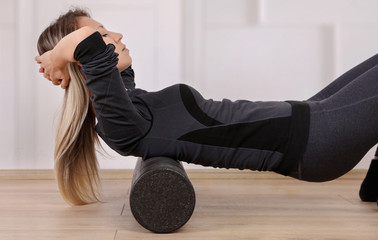Creating Your Own Soft Tissue Work
By Rina Ishii, DPT
AZOPT Goodyear Physical Therapist
Most are familiar with the acronym RICE to help with pain after an injury – Rest, Ice, Compression, Elevate. While there are many benefits to following this method, there are also more active approaches to help initiate and supplement the health process. One method is foam rolling, also known as soft tissue work.
What is it?
Soft tissue work is a hands-on approach a physical therapist will use to improve the quality of soft tissues such as skin, muscle, fascia, tendons, and ligaments.
Right after an injury, your body does its best to heal injured tissue. During this process, adhesions in and around the healing tissue may be formed. Additionally, muscles around the injury are constantly “on” in order to protect your body, creating tension or even trigger points. All of this can be culprits of localized pain. To combat this, soft tissue work helps break up adhesions and decrease tension in order to promote healing and restore function.
Other benefits of soft tissue work:
- Reduce swelling/edema.
- Promote circulation to the area.
- Promote relaxation.
- Stretch and lengthen soft tissues.
Soft tissue work and foam rolling is not only for minor injuries. It is also a great way to prepare for activity or to help relax muscles after activity. You probably see people foam rolling in the gym all the time – this is an example of soft tissue work!
How to perform your own soft tissue work?
Performing soft tissue work yourself is easy! It involves applying pressure and slowly working into and around an affected area. Do this by applying a sustained pressure to a specific area for 10-30 seconds, or dynamically apply pressure while moving along the targeted areas. The amount of pressure is up to your tolerance since these areas are usually sensitive and tender.
A gradual increase from light to medium and then eventually to firm pressure is recommended. You can use your hands to provide pressure or use tools such as a foam roller, a ball (tennis or lacrosse balls), a massage roller/ball, or even a big ice cube to help knead things out. You can perform this for 5 to 15 minutes at a time. If you have worked on tissues with firm pressure, it would be good to wait 24-48 hours before performing it again to prevent overuse. If soft tissue work is too painful, please discontinue and consult a healthcare provider regarding your pain.
Things to keep in mind:
- Going harder or more pain is not necessarily better.
- You may be sore, but the soreness should go away within a day or two.
- Stay hydrated before and after.
- If you have suffered a larger injury, please seek medical attention; especially if the pain continues or worsens over a few days.
To learn more about different ways to use the foam roller, click here to check out our blog on Foam Rolling 101.








